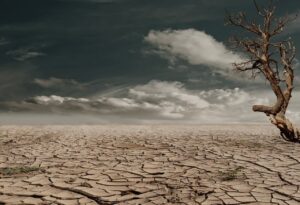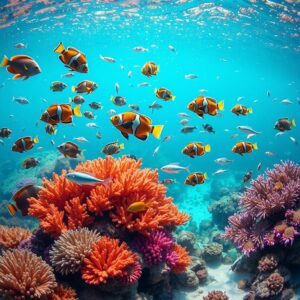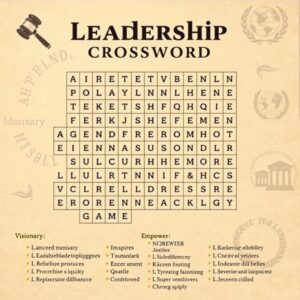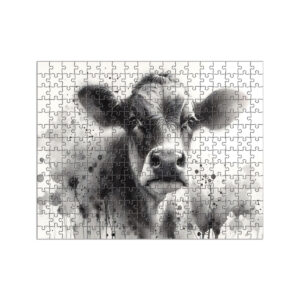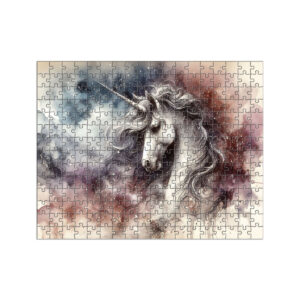
Explore & Play
Discover interesting topics and solve the accompanying crossword puzzle.
Period Crossword | Earth’s Geological Ages
Table of Contents
Welcome to our exploration of Earth’s geological history! Before diving into the details of each geological period in our comprehensive article, we invite you to challenge yourself with our Period crossword. This crossword puzzle is a fun way to test your knowledge of the different periods and epochs. If you’re new to the topic or need a refresher, feel free to start with the article for a detailed overview and then return to the crossword to see how much you’ve learned. Enjoy the journey through time!
Period Crossword
You can either fill in the crossword puzzle directly on this page or click the button in the bottom right corner to print it for free.
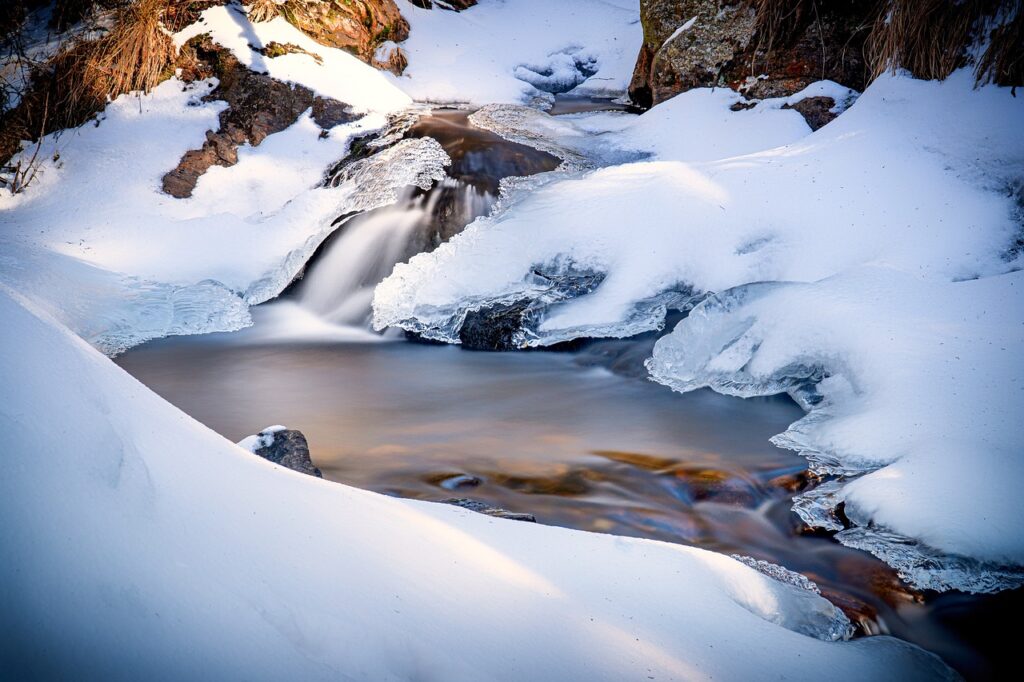
A Journey Through Time: The Complete Guide to Earth's Geological Periods
Earth’s history is written in the rocks, spanning billions of years and revealing a story of dramatic changes, from the emergence of early life to the age of mammals. These geological periods help us understand the dynamic evolution of the planet, offering insights into everything from the formation of mountains to the rise and fall of entire species. In this article, we’ll embark on a fascinating journey through time, uncovering the mysteries and marvels of Earth’s many periods. Ready to dive deep? Keep reading, and don’t forget to challenge yourself with our crossword puzzle at the end!
I. The Dawn of Life: Early Paleozoic Periods
Our journey begins in the Paleozoic Era, a time of incredible biological diversity and dramatic changes in Earth’s environments. From the quiet beginnings in the Cambrian period to the dramatic climax of the Permian, these periods set the stage for life as we know it.
A. The Cambrian Explosion
Known as the ‘Cambrian Explosion,’ this period witnessed the rapid emergence of complex life forms in the oceans. Around 541 million years ago, Earth’s first multicellular organisms diversified at an astonishing rate. Trilobites, brachiopods, and other marine creatures dominated the seas, marking the birth of most modern animal phyla. The Cambrian period also saw the development of the first reefs, which provided habitats for a wide array of marine life, illustrating the rapid pace of ecological change.
B. Ordovician Seas and the First Coral Reefs
Following the Cambrian, the Ordovician period saw the rise of vast coral reefs and an abundance of marine life. During this time, the planet’s oceans were filled with diverse organisms, including brachiopods, bryozoans, and the first true fish. Sea levels were high, and shallow continental shelves became the perfect environment for coral reefs to flourish, setting the stage for a rich marine ecosystem that persisted throughout much of Earth’s history.
C. The Silurian Landscape and Vascular Plants
As life began to colonize land, the Silurian period saw the emergence of the first vascular plants and jawed fish. Around 443 million years ago, early land plants like Cooksonia started to spread across damp environments. This transition to land was a game-changer, as it paved the way for more complex terrestrial ecosystems. Meanwhile, in the oceans, fish developed jaws for the first time, which significantly altered marine food webs and predator-prey dynamics.
D. Devonian: The Age of Fishes
The Devonian period, often called the ‘Age of Fishes,’ was a time when vertebrate life thrived in diverse aquatic habitats. During this period, which began around 419 million years ago, fish diversified into numerous forms, from armored placoderms to the first lobe-finned fish, which are ancestors of modern tetrapods. The Devonian also witnessed the colonization of land by the first true amphibians, a significant evolutionary milestone that shaped the development of terrestrial life.
E. Carboniferous Forests and Coal Formation
During the Carboniferous, vast forests covered the Earth, setting the stage for the formation of today’s coal deposits. Dense, swampy forests dominated the landscape, with towering lycophytes, ferns, and seed ferns flourishing in the warm, humid climate. These forests would eventually become the coal beds that fueled the Industrial Revolution millions of years later. Additionally, the Carboniferous period saw the rise of early reptiles, marking a pivotal moment in vertebrate evolution.
F. The Great Permian Extinction
The Permian period ended with the most significant mass extinction in Earth’s history, wiping out nearly 90% of all species. Known as “The Great Dying,” this event, which occurred around 252 million years ago, saw massive volcanic eruptions in what is now Siberia, causing dramatic climate shifts, ocean acidification, and habitat loss. Despite this catastrophic end, the Permian period laid the groundwork for the Mesozoic Era, where life would find a way to recover and diversify once more.
II. The Age of Reptiles: Mesozoic Era
After the devastation of the Permian extinction, life rebounded in the Mesozoic Era, known as the ‘Age of Reptiles.’ This era, spanning from approximately 252 to 66 million years ago, is characterized by the dominance of dinosaurs and the gradual emergence of mammals and birds.
A. Triassic: A New Beginning
In the Triassic period, life slowly recovered from the Permian extinction, and the first dinosaurs began to emerge. This period was marked by the development of new ecosystems and the rise of diverse plant and animal species. Reptiles, particularly archosaurs, became the dominant land animals, while the first mammals and true crocodiles appeared. As terrestrial life diversified, the Triassic seas also saw new life forms, including marine reptiles like ichthyosaurs and plesiosaurs.
B. Jurassic: The Reign of Dinosaurs
The Jurassic period was marked by the dominance of large dinosaurs and the appearance of the first birds. Around 201 million years ago, dinosaurs such as Brachiosaurus, Stegosaurus, and Allosaurus roamed the Earth’s forests and plains, while Archaeopteryx, the earliest known bird, took flight in the skies. The Jurassic also saw the diversification of gymnosperms and the establishment of vast forests, which provided ample food and habitat for the growing population of herbivorous dinosaurs.
C. Cretaceous: End of an Era
The Cretaceous period, characterized by the rise of flowering plants, ended with a cataclysmic mass extinction. From approximately 145 to 66 million years ago, angiosperms, or flowering plants, began to spread, bringing new dynamics to terrestrial ecosystems. Meanwhile, dinosaurs continued to dominate, with species like Tyrannosaurus rex and Triceratops ruling the land. However, a sudden asteroid impact around 66 million years ago led to the extinction of nearly all dinosaur species, closing the Mesozoic chapter.
III. The Rise of Mammals: Cenozoic Era
With the dinosaurs gone, the Cenozoic Era ushered in a new age dominated by mammals and birds. Spanning from 66 million years ago to the present, this era has seen the evolution of many species that are familiar to us today.
A. Paleogene: The Mammal Explosion
The Paleogene period saw a rapid diversification of mammals, filling ecological niches left vacant by dinosaurs. This time, which started 66 million years ago, was marked by the emergence of many modern mammalian groups, including primates, ungulates, and carnivores. Birds also diversified, and flowering plants became the dominant vegetation, supporting new types of herbivores and predators.
B. Neogene: Modernization of Ecosystems
During the Neogene, grasses spread across the continents, and many modern species began to emerge. From around 23 million years ago, Earth’s landscapes were transformed as grasslands expanded, leading to the evolution of grazing animals like horses and antelope. The period also saw the development of more complex ecosystems and the rise of early hominins, our direct ancestors.
C. Quaternary: Ice Ages and Human Evolution
The Quaternary period, which includes the current Holocene epoch, is defined by Ice Ages and the rise of Homo sapiens. Beginning around 2.6 million years ago, this period has witnessed several glacial cycles, drastically shaping Earth’s climate and environments. It is also notable for the evolution of modern humans, who emerged around 300,000 years ago and began to spread across the globe.
D. Holocene: The Age of Humans
The Holocene epoch, beginning around 11,700 years ago, marks the era of human civilization and significant environmental changes. Human societies have developed complex cultures, built cities, and dramatically altered landscapes. The Holocene is also characterized by the relatively stable climate that has allowed agriculture to flourish, setting the foundation for the modern world.
IV. Exploring Geological Transitions: From Epochs to Ages
Geological periods are further divided into epochs and ages, each revealing unique characteristics and life forms. Understanding these divisions helps paint a more detailed picture of Earth’s history.
A. Understanding the Epochs
Epochs like the Eocene, Miocene, and Pleistocene reveal specific intervals within geological periods that highlight evolutionary milestones. The Eocene, for example, saw the rise of early mammals like whales, while the Miocene witnessed the spread of grasses and the diversification of primates. Meanwhile, the Pleistocene is famous for its Ice Ages and the evolution of modern humans.
B. Significant Ages and Their Impact
Ages such as the Maastrichtian and Tithonian capture unique moments in Earth’s history, from mass extinctions to the rise of new life forms. The Maastrichtian age, for example, is notable for the extinction event that wiped out the dinosaurs, while the Tithonian age saw significant developments in marine life, including the diversification of ammonites.
A Final Look Back: Reflecting on Earth’s Dynamic Past
From the Cambrian seas to the Holocene epoch, Earth’s geological timeline is a testament to the planet’s dynamic nature and its capacity for change. Each period, epoch, and age represents a unique chapter in the story of our planet, shaped by incredible transformations and the resilience of life.
Challenge yourself with our crossword puzzle to test your knowledge of Earth’s fascinating history and discover even more hidden wonders!
Share to...
I hope you enjoy the content.
Want to receive our daily crossword puzzle or article? Subscribe!
You may also be interested in
Share to…
Want to receive our daily crossword puzzle?
-
Jigsaw Puzzles
Twelve Zodiac Cow Ink Wash Jigsaw Puzzle 250 | 300 | 500 Pieces
kr 348,00 – kr 439,00Price range: kr 348,00 through kr 439,00 Select options This product has multiple variants. The options may be chosen on the product page -
Jigsaw Puzzles
Majestic Unicorn Watercolor Puzzle 250 | 300 | 500 Brikker
kr 348,00 – kr 439,00Price range: kr 348,00 through kr 439,00 Select options This product has multiple variants. The options may be chosen on the product page -
Jigsaw Puzzles
Lofoten Serenity: Abstract Puzzle 250 | 300 | 500 Pieces
kr 348,00 – kr 439,00Price range: kr 348,00 through kr 439,00 Select options This product has multiple variants. The options may be chosen on the product page





